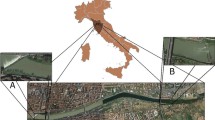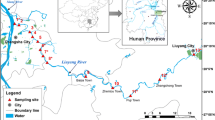Abstract
Seabass (Lateolabrax japonicus) is a major aquacultured fish species worldwide. The bioconcentration, bioaccumulation, and biomagnification of metals in water, sediments, and commercial feed were investigated in L. japonicus from an aquaculture pond in the Pearl River Delta of South China. Aluminum (Al), chromium (Cr), manganese (Mn), iron (Fe), nickel (Ni), copper (Cu), zinc (Zn), arsenic (As), cadmium (Cd), and lead (Pb) were determined in the dorsal muscle, viscera, backbone, gill, and stomach contents of L. japonicus. The gill and stomach contents had higher levels of bioconcentration of most metals than other parts of fish. Based on the bioaccumulation factor, the gill and backbone exhibited the highest accumulation of Zn, while the viscera had the highest capacity to accumulate Cu. The mean biomagnification factor values exceeded for As in dorsal muscle, for Cu in the viscera, for Cr and Pb in the gill, and for Al, Cr, Fe, Cu, and Pb in the stomach contents, indicating efficient bioaccumulation from commercial feed and their habitat. Non-metric multidimensional scaling analysis revealed two groups that resulted from the accumulation of metals in various parts of L. japonicus. Moreover, health risk assessment indicated that no notable adverse health effects occurred from the ingestion of L. japonicus.





Similar content being viewed by others
Data Availability
All data generated or analyzed during this study are included in this published article.
References
Cheng Z, Man YB, Nie XP, Wong MH (2013) Trophic relationships and health risk assessments of trace metals in the aquaculture pond ecosystem of Pearl River Delta, China. Chemosphere 90:2142–2148. https://doi.org/10.1016/j.chemosphere.2012.11.017
Gui JF, Tang QS, Li ZJ, Liu JS, Sena SDS (2018) Aquaculture in China — success stories and modern trends. Wiley Blackwell, Padstow
Lu QQ, Bai JH, Zhang GL, Wu JJ (2020) Effects of coastal reclamation history on heavy metals in different types of wetland soils in the Pearl River Delta: Levels, sources and ecological risks. J Clean Prod 272:122668. https://doi.org/10.1016/j.jclepro.2020.122668
Wang MX et al (2019) Loss accounting of environmental pollution within Pearl River Delta region, South China. Environ Pollut 249:676–685. https://doi.org/10.1016/j.envpol.2019.03.081
Gu YG, Gao YP, Huang HH, Wu FX (2020) First attempt to assess ecotoxicological risk of fifteen rare earth elements and their mixtures in sediments with diffusive gradients in thin films. Water Res 185:116254. https://doi.org/10.1016/j.watres.2020.116254
Hu YA, Cheng HF (2013) Application of Stochastic models in identification and apportionment of heavy metal pollution sources in the surface soils of a large-scale region. Environ Sci Technol 47:3752–3760. https://doi.org/10.1021/es304310k
Gu YG (2021) Risk assessment of eight metals and their mixtures to aquatic biota in sediments with diffusive gradients in thin films (DGT): a case study in Pearl River intertidal zone. Environ Sci Eur 33:122. https://doi.org/10.1186/s12302-021-00564-1
Gu YG, Li QS, Fang JH, He BY, Fu HB, Tong ZJ (2014) Identification of heavy metal sources in the reclaimed farmland soils of the Pearl River Estuary in China using a multivariate geostatistical approach. Ecotoxicol Environ Saf 105:7–12. https://doi.org/10.1016/j.ecoenv.2014.04.003
Gu YG, Wang ZH, Lu SH, Jiang SJ, Mu DH, Shu YH (2012) Multivariate statistical and GIS-based approach to identify source of anthropogenic impacts on metallic elements in sediments from the mid Guangdong coasts, Chian. Environ Pollut 163:248–255. https://doi.org/10.1016/j.envpol.2011.12.041
Signa G, Mazzola A, Tramati CD, Vizzini S (2017) Diet and habitat use influence Hg and Cd transfer to fish and consequent biomagnification in a highly contaminated area: Augusta Bay (Mediterranean Sea). Environ Pollut 230:394–404. https://doi.org/10.1016/j.envpol.2017.06.027
NasyitahSobihah N, Ahmad Zaharin A, KhairulNizam M, Ley Juen L, Kyoung-Woong K (2018) Bioaccumulation of heavy metals in maricultured fish, Lates calcarifer (Barramudi), Lutjanus campechanus (red snapper) and Lutjanus griseus (grey snapper). Chemosphere 197:318–324. https://doi.org/10.1016/j.chemosphere.2017.12.187
Shilla D, Pajala G, Routh J, Dario M, Kristoffersson P (2019) Trophodynamics and biomagnification of trace metals in aquatic food webs: the case of Rufiji estuary in Tanzania. Appl Geochem 100:160–168. https://doi.org/10.1016/j.apgeochem.2018.11.016
Barwick M, Maher W (2003) Biotransference and biomagnification of selenium copper, cadmium, zinc, arsenic and lead in a temperate seagrass ecosystem from Lake Macquarie Estuary, NSW, Australia Marine. Environ Res 56:471–502. https://doi.org/10.1016/S0141-1136(03)00028-X
Zhang W, Wang WX (2012) Large-scale spatial and interspecies differences in trace elements and stable isotopes in marine wild fish from Chinese waters. J Hazard Mater 215–216:65–74. https://doi.org/10.1016/j.jhazmat.2012.02.032
Afonso C, Lourenço HM, Cardoso C, Bandarra NM, Carvalho ML, Castro M, Nunes ML (2013) From fish chemical characterisation to the benefit-risk assessment — Part A. Food Chem 137:99–107. https://doi.org/10.1016/j.foodchem.2012.10.014
Rajeshkumar S, Liu Y, Zhang XY, Ravikumar B, Bai G, Li XY (2018) Studies on seasonal pollution of heavy metals in water, sediment, fish and oyster from the Meiliang Bay of Taihu Lake in China. Chemosphere 191:626–638. https://doi.org/10.1016/j.chemosphere.2017.10.078
Łuczyńska J, Paszczyk B, Łuczyński MJ (2018) Fish as a bioindicator of heavy metals pollution in aquatic ecosystem of Pluszne Lake, Poland, and risk assessment for consumer’s health. Ecotoxicol Environ Saf 153:60–67. https://doi.org/10.1016/j.ecoenv.2018.01.057
Kalantzi I, Black KD, Pergantis SA, Shimmield TM, Papageorgiou N, Sevastou K, Karakassis I (2013) Metals and other elements in tissues of wild fish from fish farms and comparison with farmed species in sites with oxic and anoxic sediments. Food Chem 141:680–694. https://doi.org/10.1016/j.foodchem.2013.04.049
Tlusty MF et al (2019) Reframing the sustainable seafood narrative. Glob Environ Chang 59:101991. https://doi.org/10.1016/j.gloenvcha.2019.101991
Bosch AC, O’Neill B, Sigge GO, Kerwath SE, Hoffman LC (2016) Heavy metals in marine fish meat and consumer health: a review. J Sci Food Agric 96:32–48. https://doi.org/10.1002/jsfa.7360
Gu Y-G, Ning J-J, Ke C-L, Huang H-H (2018) Bioaccessibility and human health implications of heavy metals in different trophic level marine organisms: a case study of the South China Sea. Ecotoxicol Environ Saf 163:551–557. https://doi.org/10.1016/j.ecoenv.2018.07.114
FAO (Food and Agriculture Organization) (2018) The state of world fisheries and aquaculture 2018. FAO Web. http://www.fao.org/family-farming/detail/en/c/1145050/
Hannah R, Max R (2017) Meat and seafood production and consumption. Our Word In Data Web. https://ourworldindata.org/meat-and-seafood-production-consumption.
Cao L, Naylor R, Henriksson P, Duncan L, Metian M, Troell M, Zhang WB (2015) China’s aquaculture and the world’s wild fisheries. Science 347:133–135. https://doi.org/10.1126/science.1260149
Wu YY, Li B, Zhu XJ, Wei Y, Yang XQ, Chen SJ (2016) Comparison of nutrient composition of cultured sea bass and cultured fresh-water bass, Lateolabrax japonicus and Micropterus salmoides. Sci Technol Food Ind 37:348–359. https://doi.org/10.13386/j.issn1002-0306.2016.20.061
FAO (Food and Agriculture Organization) (2017) TOP 10 species groups in global aquaculture 2017. FAO Web. http://www.fao.org/3/ca5224en/ca5224en.pdf.
Martins CIM, Eding EH, Verreth JAJ (2011) The effect of recirculating aquaculture systems on the concentrations of heavy metals in culture water and tissues of Nile tilapia Oreochromis niloticus. Food Chem 126:1001–1005. https://doi.org/10.1016/j.foodchem.2010.11.108
Liu HQ, Liu GJ, Yuan ZJ, Ge M, Wang SS, Liu Y, Da CN (2019) Occurrence, potential health risk of heavy metals in aquatic organisms from Laizhou Bay, China. Marine Pollut Bull 140:388–394. https://doi.org/10.1016/j.marpolbul.2019.01.067
Lin YH, Yang RX (2020) Doumen Ecological Agriculture Park. Dara Web. http://dara.gd.gov.cn/snnyxxlb/content/post_3073061.html.
Lin BZ, Liu ZF, Eglinton TI, Kandasamy S, Blattmann TM, Haghipour N, de Lange GJ (2019) Perspectives on provenance and alteration of suspended and sedimentary organic matter in the subtropical Pearl River system, South China. Geochim Cosmochim Acta 259:270–287. https://doi.org/10.1016/j.gca.2019.06.018
Li HJ, Lin L, Ye S, Li HB, Fan JF (2017) Assessment of nutrient and heavy metal contamination in the seawater and sediment of Yalujiang Estuary. Mar Pollut Bull 117:499–506. https://doi.org/10.1016/j.marpolbul.2017.01.069
Gu YG, Lin Q, Wang XH, Du FY, Yu ZL, Huang HH (2015) Heavy metal concentrations in wild fishes captured from the South China Sea and associated health risks. Mar Pollut Bull 96:508–512. https://doi.org/10.1016/j.marpolbul.2015.04.022
Jahan S, Strezov V (2019) Assessment of trace elements pollution in the sea ports of New South Wales (NSW), Australia using oysters as bioindicators. Sci Rep 9:1416. https://doi.org/10.1038/s41598-018-38196-w
Arnot JA, Gobas FAPC (2006) A review of bioconcentration factor (BCF) and bioaccumulation factor (BAF) assessments for organic chemicals in aquatic organisms. Environ Rev 14:257–297. https://doi.org/10.1139/a06-005
Gu YG, Lin Q, Huang HH, Wang LG, Ning JJ, Du FY (2017) Heavy metals in fish tissues/stomach contents in four marine wild commercially valuable fish species from the western continental shelf of South China Sea. Mar Pollut Bull 114:1125–1129. https://doi.org/10.1016/j.marpolbul.2016.10.040
NBSC (National Bureau of Statistics of China) (2015) China Statistical Yearbook 2014. http://www.stats.gov.cn/tjsj/ndsj/2014/indexeh.htm.
USEPA (U.S. Environmental Protection Agency) (2018) Regional Screening Levels (RSLs) — summary table. USEPA Web. https://www.epa.gov/risk/regional-screening-levels-rsls-generic-tables.
Chen L, Xu LY, Yang ZF (2019) Inequality of industrial carbon emissions of the urban agglomeration and its peripheral cities: a case in the Pearl River Delta, China. Renew Sustain Energy Rev 109:438–447. https://doi.org/10.1016/j.rser.2019.04.010
Gu YG, Huang HH, Liu Y, Gong XY, Liao XL (2018) Non-metric multidimensional scaling and human risks of heavy metal concentrations in wild marine organisms from the Maowei Sea, the Beibu Gulf, South China Sea. Environ Toxicol Pharmacol 59:119–124. https://doi.org/10.1016/j.etap.2018.03.002
FAO (Food and Agriculture Organization) (1983) Compilation of legal limits for hazardous substances in fish and fishery products. FAO Fishery Circular No 464. Food and Agriculture Organization of the United Nations, Rome, pp 5–10
Yılmaz AB, Sangün MK, Yağlıoğlu D, Turan C (2010) Metals (major, essential to non-essential) composition of the different tissues of three demersal fish species from İskenderun Bay, Turkey. Food Chem 123:410–415. https://doi.org/10.1016/j.foodchem.2010.04.057
Subotić S et al (2013) Heavy metal and trace element bioaccumulation in target tissues of four edible fish species from the Danube River (Serbia). Ecotoxicol Environ Saf 98:196–202. https://doi.org/10.1016/j.ecoenv.2013.08.020
Chua EM, Flint N, Wilson SP, Vink S (2018) Potential for biomonitoring metals and metalloids using fish condition and tissue analysis in an agricultural and coal mining region. Chemosphere 202:598–608. https://doi.org/10.1016/j.chemosphere.2018.03.080
Voigt CL, da Silva CP, Doria HB, Randi MAF, de Oliveira Ribeiro CA, de Campos SX (2015) Bioconcentration and bioaccumulation of metal in freshwater Neotropical fish Geophagus brasiliensis. Environ Sci Pollut Res 22:8242–8252. https://doi.org/10.1007/s11356-014-3967-4
Wei YH, Zhang JY, Zhang DW, Tu TH, Luo LG (2014) Metal concentrations in various fish organs of different fish species from Poyang Lake, China. Ecotoxicol Environ Saf 104:182–188. https://doi.org/10.1016/j.ecoenv.2014.03.001
Liang Y, Cheung RYH, Wong MH (1999) Reclamation of wastewater for polyculture of freshwater fish: bioaccumulation of trace metals in fish. Water Res 33:2690–2700. https://doi.org/10.1016/S0043-1354(98)00473-4
Fonseca AR, Sanches Fernandes LF, Fontainhas-Fernandes A, Monteiro SM, Pacheco FAL (2017) The impact of freshwater metal concentrations on the severity of histopathological changes in fish gills: a statistical perspective. Sci Total Environ 599–600:217–226. https://doi.org/10.1016/j.scitotenv.2017.04.196
Lattin JM, Carroll JD, Green PE (2003) Analyzing multivariate data. China Machine Press, Beijing
El-Moselhy KM, Othman AI, Abd El-Azem H, El-Metwally MEA (2014) Bioaccumulation of heavy metals in some tissues of fish in the Red Sea, Egypt. Egypt J Basic Appl Sci 1:97–105. https://doi.org/10.1016/j.ejbas.2014.06.001
Acknowledgements
The authors would like to thank Zhi-Hui Zhong and Bei-Bei Han (South China Sea Fisheries Research Institute, China) for their assistance in field work. We are also grateful to the anonymous reviewers for their constructive comments on the manuscript.
Funding
This study was supported by the National Key R&D Program of China (2019YFD0901105), the Central Public-interest Scientific Institution Basal Research Fund, South China Sea Fisheries Research Institute, CAFS (2018ZD01), and Central Public-interest Scientific Institution Basal Research Fund, CAFS (NO.2020TD15).
Author information
Authors and Affiliations
Contributions
The corresponding author contributed to the conception and design of the study. Material preparation, data collection, and analysis were performed by Yang-Guang Gu, Xu-Nuo Wang, Zeng-Huan Wang, Hong-Hui Huang, and Xiu-Yu Gong. The first draft of the manuscript was written by Yang-Guang Gu. All authors read and approved the final manuscript.
Corresponding author
Ethics declarations
Ethical Approval
The manuscript related to fish species was established according to the guidelines of the Committee on Publication Ethics (COPE), and the experimental protocol was approved by the Human Ethics Committee of South China Sea Fisheries Research Institute.
Competing Interests
The authors declare no competing interests.
Additional information
Publisher's Note
Springer Nature remains neutral with regard to jurisdictional claims in published maps and institutional affiliations.
Supplementary Information
Below is the link to the electronic supplementary material.
Rights and permissions
About this article
Cite this article
Gu, YG., Wang, XN., Wang, ZH. et al. Metal Biological Enrichment Capacities, Distribution Patterns, and Health Risk Implications in Sea Bass (Lateolabrax japonicus). Biol Trace Elem Res 201, 1478–1487 (2023). https://doi.org/10.1007/s12011-022-03255-x
Received:
Accepted:
Published:
Issue Date:
DOI: https://doi.org/10.1007/s12011-022-03255-x




